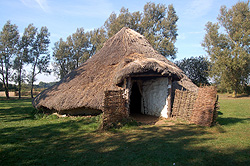Iron Age and Roman Flitwick

A reconstruction of an Iron Age roundhouse at Flag Fen October 2011
The Bedfordshire Historic Environment Record [HER] contains information on the county’s historic buildings and landscapes and summaries of each entry can now be found online as part of the Heritage Gateway website. The best known Roman site in Flitwick is at Ruxox Farm.
An area east of Denel End, now under Hinksley Road, showed cropmarks (marks in growing crops showing the presence of underground features such as buried walls, buried ditches etc.) which, before building of a housing estate were excavated [HER 573]. The cropmarks included a ring ditch, usually found to be Bronze Age round barrows, and parallel ditches which, remarkably, mirrored 18th century field boundaries shown on a contemporary map. Artefacts found included flint tools ranging from the Mesolithic to the Bronze Age in date. A succession of Iron Age occupations was found and , later, a Roman trackway and field system [HER 20126], probably part of the Ruxox Farm Roman site. Anglo-Saxon settlement evidence was also discovered.
The Viatores are a group dedicated to trying to trace Roman roads in the modern landscape. They have suggested that a Roman road ran from Dunton through Biggleswade, Edworth, Langford, Astwick, Shefford, Clifton, Henlow, Campton, Clophill, Maulden, Flitwick, Steppingley, Eversholt, Ridgmont, and Husborne Crawley to Woburn [HER 5342]. This road would have passed through or next to the Roman site at Ruxox Farm and would include a possible agger east of Denel End [HER 10456]. Aggers are long, narrow structures with convex cross-sections, thought to represent the remains of Roman roads. Another road was been suggested as running through Luton, Streatley, Barton-le-Clay, Pulloxhill, Harlington, Flitton, Maulden, Flitwick, Ampthill, Millbrook to Marston Moretaine [HER5020]; this route is highly speculative.
Cropmarks south-west of Steppingley Road [HER 564] showed a roughly circular and a rectangular enclosure. Before the area was buried beneath a housing estate excavations by Ampthill and District Archaeological and Local History Society found a Romano-British corn-drying oven of 2nd century date.
A probable rectangular enclosure identified by cropmarks south of Folly Farm [HER 577] has yielded Roman pottery, according to an annotated map produced by F Kuhlicke of Bedford Museum.